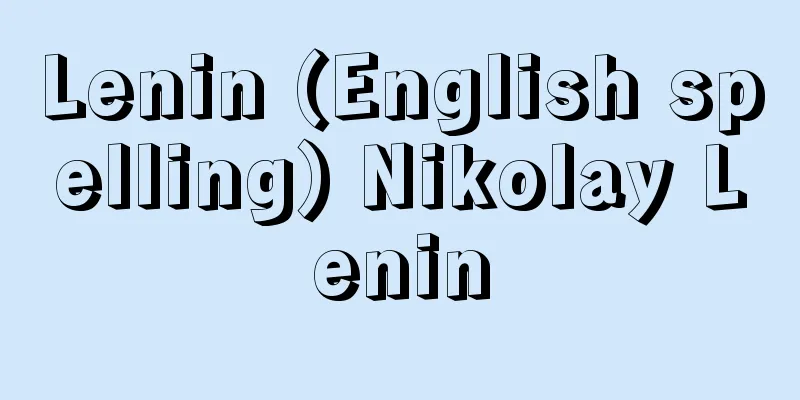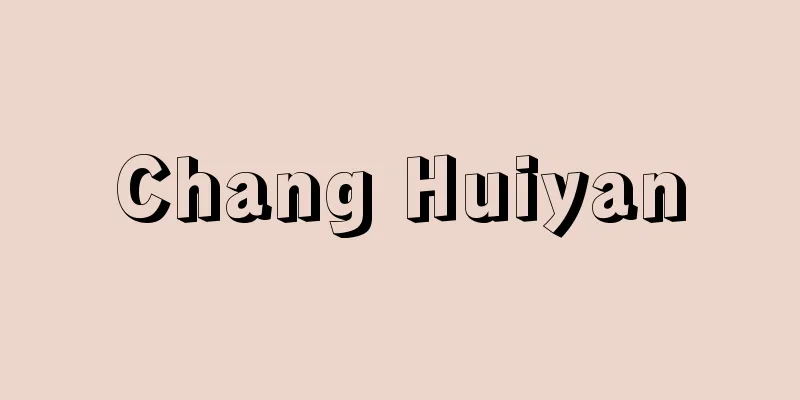Lenin (English spelling) Nikolay Lenin

|
His real name was Ul'yanov, but in addition to the commonly known name Lenin, he is said to have used around 150 pen names. He was the founder of the Bolshevik Party (Communist Party of the Soviet Union), led the Russian October Revolution, and established the world's first socialist state (the Soviet Union). He is considered second only to Marx and Engels for his theoretical achievements in creatively developing Marxism under new historical conditions, such as the emergence of imperialism and monopoly capitalism and the construction of socialism, but there are also movements to reexamine whether the propositions he formulated are applicable to today's developed capitalist countries. [Mitsuyoshi Ikeda] LifeHe was born on April 22, 1870 in Simbirsk (called Ulyanovsk from 1924 to 1991 after Lenin's real name) to Ilya Nikolaevich Ul'yanov (1831-1886) and Maria Alexandrovna Ul'yanova (1835-1916), the third of six children. His father was a progressive educator who served as a middle school principal and a school inspector, and Lenin was raised in a strict but liberal home environment, which allowed him to acquire a wide range of knowledge and is said to have been an outstanding student. At the age of 17, his older brother Aleksandr Ilyich Ul'yanov (1866-1887), who was a Narodnik ideologist, was executed for participating in a plot to assassinate Tsar Alexander III. This had a great impact on Lenin's view of society. In 1887, he entered the law faculty of Kazan University, where he joined the student movement, but was arrested, expelled, and exiled to the village of Kokshkino (Kazan Prefecture). There, he thoroughly read Chernyshevsky's What Is to Be Done?, which was also his brother Alexander's favorite book, and began his serious struggle to overcome Narodnikism. In the following year, 1888, he returned to Kazan and joined a Marxist circle, where he first came across Marx's Das Kapital. In 1891, he passed the state examination at St. Petersburg University with outstanding results, and the following year, 1892, he worked as an assistant lawyer in Samara, before returning to St. Petersburg in 1893. There he met Krupskaya, who would later become his wife, and wrote and published What is a Friend of the People? (1894) with the aim of criticizing the liberal Narodniks. In 1895 he visited various parts of Europe, and in Switzerland he came into contact with Plekhanov, a representative of the Labor Liberation Movement. After returning to Russia, he founded the Working Class Liberation Struggle Union in St. Petersburg, but was arrested and imprisoned in December, and in 1897 he was exiled to Siberia. There he married Krupskaya, who had also been exiled, and in 1899 he finished writing The Development of Capitalism in Russia, which argued for the possibility and inevitability of the development of capitalism in Russia. In January 1900, his exile ended, and in July he fled to Western Europe, where in December he founded the newspaper Iskra, with the aim of organizing a militant Marxist party to oppose the economists and legal Marxists. Around this time, he published What is to be Done? (1902) and An Appeal to the Peasants (1903) for the same purpose. In 1903, he participated in the Second Congress of the Russian Democratic Socialist Party, but the Leninist faction (Bolsheviks = majority) came into conflict with the Martovist faction (Mensheviks = minority) over organizational principles and was defeated. In 1905, he experienced the First Russian Revolution, and published Two Tactics of the Social Democracy in the Democratic Revolution, proposing Bolshevik tactics with the alliance of workers and peasants as its central idea. After the revolution failed, he was forced to go into exile again (1907), but in Materialism and Empirio-Criticism (1909) he criticized the opportunistic idealism that spread during the reactionary period, and founded magazines and newspapers such as Zvezda (1910), Prosveshcheniye (1911), and Pravda (1912). In early 1912, he expelled the Mensheviks from the party conference in Prague, and the Bolsheviks succeeded in rebuilding the party. In 1914, World War I broke out, and Lenin was arrested on suspicion of espionage, but was released and moved to Switzerland. In his book The War and the Russian Social Democracy (1914), he analyzed the imperialist character of the war, criticized the parties of the Second International for shifting to a position of supporting the war and defending their own government, and put forward the slogans "the transformation of the imperialist war into civil war" and "the defeat of our own government." From 1915 to 1916, he organized an international conference of anti-war (international) socialists, while also beginning to study imperialism, which culminated in his book Imperialism as the Highest Stage of Capitalism (1916). In 1917, he received news of the outbreak of the February Revolution, and at the end of March, he infiltrated Russia via Finland on a sealed train. On April 4, he published "Tasks of the Proletariat in the Present Revolution" (the so-called "April Theses"), proposing a policy of transition to socialism under the slogan "All power to the Soviets". In July, he escaped the oppression of the Provisional Government and went into hiding in Finland, where he wrote "The State and Revolution" (1917). He then hid in a locomotive and again infiltrated Russia, succeeding in the October Revolution and being elected Chairman of the People's Commissariat. In March 1918, he signed the Treaty of Brest-Litovsk with Germany, and in "Immediate Tasks of the Soviet Power" he set out a policy of socialist construction, but due to the occurrence of counter-revolutionary civil wars and military intervention by the great powers, he embarked on a wartime communist system. He also succeeded in founding the Comintern (Third International) in March 1919, and from 1920 to 1921, as the civil war and military intervention subsided, he transitioned to a New Economic Policy and worked to rebuild the economy. After suffering from several attacks of encephalopathy from 1922 onwards, he died on January 21, 1924 in the suburbs of Moscow (village of Gorki). His body is kept in a mausoleum in Moscow's Red Square. [Mitsuyoshi Ikeda] PersonalityLenin was rather small in stature, had a simple Slavic appearance, and is said to have had a very simple attitude towards life. However, throughout his eventful 52-year life, which included exile and refugee status, he was always energetically devoted to theoretical and practical activities, and was sharp in both words and deeds. Even Trotsky, who disagreed with Lenin on many points, had a high opinion of Lenin as a person. He also had a wide range of interests and understanding for art and culture, and is famous for the tolerant attitude he showed towards Gorky. [Mitsuyoshi Ikeda] Ideological characteristicsLenin is considered theoretically to have not only applied Marxism to a developing country like Russia, but also to have creatively developed it under the new historical conditions of the era of imperialism and socialist revolution, but the validity of Lenin's theories for the highly developed Western capitalist countries and the new conditions of the present day is being reexamined within Marxist circles. His main theoretical achievements include his comprehensive analysis of imperialism as the "highest and final stage of capitalism" and the "eve of socialist revolution", his theory of uneven capitalism leading to the inevitability of imperialist wars by the great powers seeking to redivide the world, his establishment of the possibility of socialist revolution in the weakest link of imperialist countries, his positioning of the liberation struggles of oppressed nations as part of the world revolution, his raising the issue of an alliance between the working class and peasants in the socialist revolution and socialist construction, and his advocacy of the need for a new type of workers' party that would take root widely among the general public, including workers, and that would adopt democratic centralism as its organizational principle. [Mitsuyoshi Ikeda] Introduction to JapanLenin's name became generally known in Japan after the Russian Revolution. Prior to that, it is known that Colonel Akashi Motojiro, who was engaged in intelligence activities at the time around the time of the Russo-Japanese War (1904-1905), had been paying attention to Lenin as one of the Russian radicals. "On the Tasks of the Russian Social Democratic Party in the Russian Revolution," published in Shinshakai by Sakai Toshihiko in 1917 (Taisho 6), was the first of Lenin's works to be translated into Japanese. [Mitsuyoshi Ikeda] "The Complete Works of Lenin, compiled and translated by the Institute of Marxism-Leninism, 45 volumes (1953-1969, Otsuki Shoten)" ▽ "Memories of Lenin, volumes 1 and 2, by Krupskaya and translated by Utsumi Shuhei (Aoki Bunko/New Edition, 1990, Aoki Shoten)" ▽ "Lenin and the Russian Revolution, by Christopher Hill, translated by Oka Minoru (Iwanami Shinsho)" ▽ "Lenin: A Life by Walter, translated by Tachibana Seiji (Kadokawa Bunko)" [References] | | | | | | | | | | | | | [Supplementary Material] |Facing the northeast wall of the Kremlin, large-scale parades were held here during the Soviet era. Lenin's Mausoleum is in the center of the photo. Inside the wall, the Presidential Palace (right) and the Presidential Residence can be seen. Part of the World Heritage Site "Moscow Kremlin and Red Square" (Russia, registered in 1990) Russia Moscow ©Shogakukan "> Red Square and Lenin's Mausoleum Source: Shogakukan Encyclopedia Nipponica About Encyclopedia Nipponica Information | Legend |
|
本名はウリヤーノフ Ульянов/Ul'yanov であるが、一般的に知られているレーニンの名のほか150ほどのペンネームを使ったといわれる。ボリシェビキ党(ソ連共産党)の創設者で、ロシア十月革命を指導、世界で初めての社会主義国家(ソビエト連邦)を樹立した。マルクス主義を帝国主義・独占資本主義の出現や社会主義の建設といった新しい歴史的条件のもとで創造的に発展させた理論的功績も大きく、マルクスやエンゲルスに次ぐ評価を与えられているが、彼の定式化した諸命題が今日の発達した資本主義諸国にも妥当するのかどうか等をめぐって再検討の動きもある。 [池田光義] 生涯1870年4月22日、シンビルスク(レーニンの本名にちなんで、1924~1991年はウリヤノフスクとよばれた)で、父イリヤー・ニコラーエビチIlya Nikolaevich Ul'yanov(1831―1886)と母マーリア・アレクサンドローブナMaria Alexandrovna Ul'yanova(1835―1916)の間に6人兄弟の3番目の子として生まれた。父親は中学校校長、国民学校視学官などを務めた進歩的な教育者で、レーニンは厳格ながらも自由主義的な雰囲気の支配する家庭環境のもとで、幅広い教養を身につけることができ、学業も非常に優秀であったといわれる。17歳のとき、ナロードニキ思想に傾倒した兄アレクサンドルAleksandr Ilyich Ul'yanov(1866―1887)が皇帝アレクサンドル3世の暗殺計画に参加した罪で処刑され、これがレーニンの社会観に大きな影響を与えた。1887年にカザン大学法学部に入学、学生運動に加わるが逮捕されて退学処分となり、コクシキノ村(カザン県)に追放された。ここで兄アレクサンドルの愛読書でもあったチェルヌィシェフスキーの『なにをなすべきか』を熟読、ナロードニキ主義克服のための本格的格闘が始まった。翌1888年カザンに戻り、マルクス主義的サークルに参加、マルクスの『資本論』にも初めて触れた。1891年にペテルブルグ大学で抜群の成績で国家検定試験に合格、翌1892年サマラで弁護士補として活動したのち、1893年ふたたびペテルブルグへ向かった。ここでのちに妻となるクループスカヤと知り合い、また自由主義的ナロードニキ批判を目的として『人民の友とは何か』(1894)を執筆、出版した。1895年にはヨーロッパ各地を訪れ、スイスでは労働解放団を代表するプレハーノフと接触した。帰国後、ペテルブルグに労働者階級解放闘争同盟を結成するが12月に逮捕、投獄され、1897年にはシベリアに追放される。そこで同じく流刑されたクループスカヤと結婚し、1899年にはロシアにおける資本主義の発展の可能性と必然性を論じた『ロシアにおける資本主義の発達』を書き終えた。1900年1月、流刑は終わり、7月には西ヨーロッパに亡命し、12月に経済主義者や合法マルクス主義者に対抗して戦闘的マルクス主義政党を組織するための新聞『イスクラ』を創刊した。このころ、同じ目的で『なにをなすべきか?』(1902)、『貧農に訴える』(1903)を刊行した。1903年にロシア民主社会党第2回大会に参加したが、レーニン派(ボリシェビキ=多数派)は組織原則をめぐってマルトフ派(メンシェビキ=少数派)と対立、敗北した。 1905年には第一次ロシア革命を経験、『民主主義革命における社会民主党の二つの戦術』を出版して労農同盟を中心思想としたボリシェビキの戦術を提起した。革命が失敗に終わったのち、ふたたび亡命(1907)を余儀なくされるが、『唯物論と経験批判論』(1909)で反動期に広がった日和見(ひよりみ)主義の観念論を批判したり、『ズベズダ』(1910)、『プロスベシチェーニエ』(1911)、『プラウダ』(1912)等の雑誌、新聞を創刊した。1912年初頭にはプラハの党会議でメンシェビキを除名し、ボリシェビキによる党再建に成功した。1914年に第一次世界大戦が勃発(ぼっぱつ)、レーニンもスパイ容疑で逮捕されたが釈放されてスイスに移った。『戦争とロシア社会民主党』(1914)を発表して、戦争の帝国主義的性格を分析し、第二インターナショナルの諸党が戦争支持・自国政府擁護の立場に転換したのを批判、「帝国主義戦争の内乱への転化」「自国政府の敗北」というスローガンを提起した。1915年から1916年にかけて反戦派(国際派)社会主義者の国際会議を組織する一方、帝国主義の研究にも着手、『資本主義の最高段階としての帝国主義』(1916)に結実させた。 1917年に二月革命勃発の知らせを受け、3月末に封印列車でフィンランドを経由してロシアに潜入、4月4日『現在の革命におけるプロレタリアートの任務』(いわゆる『四月テーゼ』)を発表し、「全権力をソビエトへ」のスローガンのもとに社会主義への移行の方針を提起した。7月、臨時政府の弾圧を逃れてフィンランドに潜伏、『国家と革命』(1917)を執筆した。その後、機関車に隠れてふたたびロシアに潜入し、十月革命を成功させ、人民委員会議長に選出された。1918年3月、ドイツとブレスト・リトフスク条約を結び、『ソビエト権力の当面の任務』で社会主義建設の方針を示すが、反革命内乱や列強の軍事干渉が起こったので戦時共産主義体制に着手した。また、1919年3月にコミンテルン(第三インターナショナル)の結成に成功、内乱と軍事干渉が弱まった1920年から1921年にかけて新経済政策へと移行させ、経済再建に努力した。1922年から脳軟化症による発作を数回経験したのち、1924年1月21日、モスクワ郊外(ゴールキ村)で息を引き取った。遺体はモスクワ赤の広場の廟(びょう)に安置されている。 [池田光義] 人となりレーニンの体格はむしろ小柄で、スラブ系の素朴な風貌(ふうぼう)をもち、生活態度も非常に素朴であったといわれる。だが流刑・亡命を含む波瀾(はらん)に富んだ52年の人生を通じて、終始精力的に理論的・実践的活動に打ち込み、言行ともに鋭いものがあり、多くの点でレーニンと対立したトロツキーもレーニン個人には高い評価を与えていた。芸術・文化に対しても幅広い関心と理解をもち、ゴーリキーに示した寛容な態度は有名である。 [池田光義] 思想的特徴マルクス主義をロシアという後進国に適用しただけでなく、それを帝国主義、社会主義革命の時代という新しい歴史的条件のもとで創造的に発展させたという理論的評価が与えられているが、レーニンの学説が高度に発達した西欧資本主義諸国や現代の新しい諸条件にどれだけ有効であるかは、マルクス主義勢力の内部でも再検討が行われている。おもな理論的業績として、帝国主義を「資本主義の最高かつ最後の段階」「社会主義革命の前夜」として総合的に分析したこと、資本主義の不均等発展の理論によって世界再分割を目ざす列強による帝国主義戦争の不可避性、帝国主義諸国のなかでもっとも弱い環における社会主義革命の可能性を基礎づけたこと、抑圧されている諸民族の解放闘争を世界革命の一環として位置づけたこと、社会主義革命、社会主義建設における労働者階級と農民層の同盟の問題を提起したこと、労働者などの一般大衆に幅広く根を下ろし、民主集中制を組織原則とする新しい型の労働者党の必要性を説いたこと、などがあげられる。 [池田光義] 日本への紹介レーニンの名が一般に日本で知られるようになったのはロシア革命以降のことである。それ以前には、日露戦争(1904~1905)前後に当時諜報活動に従事していた明石元二郎(あかしもとじろう)大佐がロシアの過激派の一人としてレーニンに注目していたのが知られている。1917年(大正6)堺利彦(さかいとしひこ)によって『新社会』に発表された「ロシア革命におけるロシア社会民主党の任務について」が日本で訳されたレーニンの最初の著作であった。 [池田光義] 『マルクス=レーニン主義研究所編・訳『レーニン全集』全45巻(1953~1969・大月書店)』▽『クループスカヤ著、内海周平訳『レーニンの思い出』上下(青木文庫/新装版・1990・青木書店)』▽『クリストファー・ヒル著、岡稔訳『レーニンとロシヤ革命』(岩波新書)』▽『ヴァルテル著、橘西路訳『レーニン伝』(角川文庫)』 [参照項目] | | | | | | | | | | | | | [補完資料] |クレムリンの北東側城壁に面し、ソ連時代には大規模なパレードが行われた。写真中央はレーニン廟。城壁の内側には大統領府(右)と大統領官邸がみえる。世界文化遺産「モスクワのクレムリンと赤の広場」の一部(ロシア・1990年登録) ロシア モスクワ©Shogakukan"> 赤の広場とレーニン廟 出典 小学館 日本大百科全書(ニッポニカ)日本大百科全書(ニッポニカ)について 情報 | 凡例 |
<<: Battle of Leningrad - Leningrad Kobosen
Recommend
Elisabeth
1207‐31 Saint. She is called "Elisabeth of Th...
Nonparametric method - Nonparametric method
Statistical inference that does not assume a speci...
Yoshitane Ashikaga
Year of death: 4/7/1523 (5/21/1523) Year of birth:...
Ichiyo's Diary - Ichiyo's Diary
Diary literature. This is a record of Higuchi Ichi...
Ibn Hayyān
Born: 987/988. Cordoba [Died] October 1076. A hist...
Amu Dar'ya River
A river in Central Asia. It originates from the gl...
Muneshige Tachibana
A feudal lord from the Azuchi-Momoyama period to ...
Ton That Thuyet
A Vietnamese politician of the anti-French resista...
Manson, P. (English spelling) MansonP
...The existence of elephantiasis has been known ...
Gapon Union - Gapon Union
…While studying at the seminary, he was influence...
Free verse - jiyushi (English)
It broadly refers to a style of poetry that does ...
Kanamizaki
...Shochu, made from brown sugar, is a local spec...
Khyber Pass - Khyber
→Khyber Pass Source : Heibonsha Encyclopedia About...
Kyoto University Faculty of Liberal Arts Campus Ruins - Kyoto University Faculty of Liberal Arts Campus Ruins
...In recent years, foundry ruins have been disco...
Accountant's dormitory - Shukeiryo
An office under the Ritsuryo system belonging to t...









